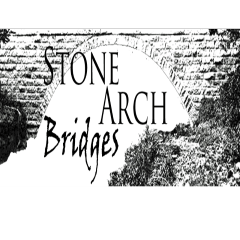Can a partially collapsed stone arch be repaired? While presenting a somewhat of a challenge, this sort of damage to a stone bridge is, nevertheless, reparable, as proved by the case of Ireland’s Avoca Village Bridge.1
The Avoca Village Bridge consists of several true semi-elliptical arches built with precision-cut stones. In August 1986, a series of floods caused scouring of one of the piers of the Avoca Village Bridge, causing the collapse of part of the pier and part of the arches. When rebuilding, the original stones were used as much as possible; however, one hundred stones were either lost or damaged. Replacements had to be precision cut at the significant expense of 50,000 pounds. Although the total cost of reinstating the Avoca Village Bridge was 135,000 pounds, the repair was significantly cheaper than simply replacing the bridge. When combined with the fact that a piece of history was saved, repairing the partially collapsed arches and pier proved to be a win-win.
A partially collapsed arch needs to receive fairly prompt attention, as the remaining portion of the arch is often made vulnerable to further damage. Therefore, when repairing a partially collapsed arch, the cause of the collapse should be ascertained, and remedied.
When the collapse is caused by scour, therefore, it is apparent that the first act towards restoring the bridge would consist of stabilizing the remaining foundations and then rebuilding the scoured foundation so that it can accept the arch.
An arch can also collapse due to other factors, such as the deterioration and falling out of stones. High velocity debris can also damage an arch by knocking out stones all on its own. Making sure the mortar joints in a mortared bridge are in good condition might help prevent this, at least to some degree.

To repair a partially collapsed arch proper, a formwork will very likely be required. This temporary form will need to be shaped to fit the correct curve of the arch to allow for proper rebuilding of the arch. After placing the form flush against the remaining portion of the arch, stones in the arch that are loose or otherwise placed in a distorted position by the partial collapse will then need to be removed. It may also be necessary to remove some of the fill above the arch as well as spandrel walls holding the fill. Where possible, the original arch stones should be used and replaced to match the original construction of the bridge.
The repair should be made to bond well with the intact portion of the arch. Typically arches fail in a corbelled fashion (something like a staircase in shape), which makes bonding to the remaining arch easier. Once the repair is complete, the formwork can be removed.
After the partially collapsed arch is repaired, it is almost certain that some of the upper layers of stonework will need rebuilt, and the fill and roadway reinstated.
Even though it is certainly not the easiest repair to be made on a stone bridge, a partially collapsed arch can, happily, be repaired. Besides preserving a piece of history, may very well be less expensive than replacing the bridge, as was the case with Ireland’s Avoca Bridge.
1This story is recounted with excellent before-and-after pictures in latest edition of Irish Stone Bridges: History and Heritage by Peter O’Keeffe and Tom Simington, revised by Rob Goodbody.

